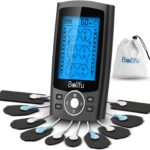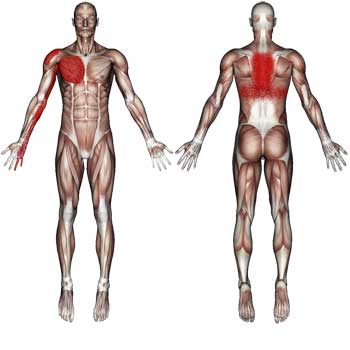The pectoralis minor (pec minor) is a small thick muscle located in the chest. Trigger points (TrPs) in the muscle can cause pain in the chest, shoulder, arm, and hand. They can also contribute to muscle pain in the upper back between the shoulder blades and a band of pain just under the shoulder blades.
A strain in the pec minor will cause pain in the muscle and surrounding area, with an exceptionally painful spot where the muscle strain occurred.

Where Is The Pectoralis Minor Muscle?
The pectoralis minor muscle is located toward the outside of the chest. It attaches the 3rd, 4th, and 5th ribs to the front of the shoulder blade (the coracoid process of the scapula).
What Movements Does It Control?
The pectoralis minor pulls the shoulder and shoulder blade down and aids with inspiration by lifting the upper ribs as you inhale.
The Pectoralis Minor Anatomy page lists origin, insertion, innervation, and blood supply information. Muscle actions are listed along with agonists and antagonists for each muscle movement.
Advertisement
Pectoralis Minor Muscles Trigger Points Symptoms:

Pain in the chest, the front of the shoulder, and the upper back are the most common symptoms of pectoralis minor trigger points. If the TrPs have caused the muscle to become tight and short, you may experience pain, tingling, and numbing down the inside of the arm to the hand and fingers.
The symptoms:
- Pain in the front of the shoulder and chest. The pain is an aching pain that can become sharp and stabbing with specific shoulder and arm movements.
- Trigger points can cause the muscle to become tight, putting pressure on the blood vessels and nerves that run under the muscle. The pressure can cause tingling and numbness on the inside of the upper arm, elbow, and inside of the forearm that often descends into the hand, including the ring finger, little finger, and occasionally the middle finger.
- Rounded shoulder posture is a common sign of a shortened pectoralis minor muscle. The muscle tightens and becomes short, pulling the shoulders forward.
- Pain in the upper back between the shoulder blades is often experienced due to the pec minor pulling the shoulders forward, causing the upper back muscles to remain in an extended stretch. A band of pain just under the shoulder blades is also common.
- Lifting your arm overhead or trying to reach behind your body may be difficult and/or cause pain.
- Coughing, sneezing, and taking deep breaths can be painful.
 Sombra Warm Therapy Gel is recommended for relaxing muscles and relieving pain. It warms without the burning heat of other gels. An excellent choice for pain caused by trigger points, muscle/joint over-use and stiffness, and arthritis. (Not sold in stores)
Sombra Warm Therapy Gel is recommended for relaxing muscles and relieving pain. It warms without the burning heat of other gels. An excellent choice for pain caused by trigger points, muscle/joint over-use and stiffness, and arthritis. (Not sold in stores)
 Medical professionals and trainers recommend Biofreeze Professional Gel for the pain and symptoms of muscle strains. It provides excellent pain relief and may help reduce inflammation caused by a strain. Biofreeze also helps relieve irritation and reduce inflammation after trigger point treatments.
Medical professionals and trainers recommend Biofreeze Professional Gel for the pain and symptoms of muscle strains. It provides excellent pain relief and may help reduce inflammation caused by a strain. Biofreeze also helps relieve irritation and reduce inflammation after trigger point treatments.
What Causes Trigger Points To Develop?
- Working with your arms out in front of the body. Using computers/laptops can put enormous strain on the pec minor if your arms are not supported. Sitting in a chair and reaching to use the keyboard rolls the shoulders forward and shortens the pec minor, putting pressure on blood vessels and nerves that run under the muscle.
- Jobs or hobbies that require holding the arms up and overhead for extended periods.
- Lifting heavy objects using your shoulders and arms without engaging the leg muscles to lift will strain the muscle. Picking up items with your arms straight out in front of the body is another muscle stressor.
- Exercises like push-ups and planks require your arms and shoulders to lift and hold your body up. Start slowly and build up the number of reps and time you hold the position.
- Carrying a heavy purse or backpack can put pressure on the muscle cutting off circulation. This contributes to carpal tunnel or thoracic outlet syndrome symptoms of aching, numbness, and tingling in the shoulder, arm, and hand.
- Women with large breasts often experience shortened pectoralis minor muscles and upper back pain caused by the shortened muscles and trigger points in the muscles.
- The pec minor is affected by conditions that cause coughing and sneezing like allergies, pneumonia, and COPD.
- People who take short, shallow breaths, known as chest breathing, stress the pectoralis minor.
- Whiplash will often cause trigger points to develop in the muscle.
TWD Recommends
 If you have rounded shoulder, forward head posture, or a habit of slouching, correcting your posture will reduce muscle pain. The Truweo Posture Corrector is adjustable and comfortable. It gently pulls your shoulders back, which helps retrain muscle memory to maintain proper posture. Many people notice an immediate reduction of pain and tension. Start slowly, wearing the brace for short periods throughout the day, gradually increasing the time-worn.
If you have rounded shoulder, forward head posture, or a habit of slouching, correcting your posture will reduce muscle pain. The Truweo Posture Corrector is adjustable and comfortable. It gently pulls your shoulders back, which helps retrain muscle memory to maintain proper posture. Many people notice an immediate reduction of pain and tension. Start slowly, wearing the brace for short periods throughout the day, gradually increasing the time-worn.
How To Avoid Development of Trigger Points In The Pectoralis Minor Muscle
- Pay attention to your posture! Keeping the shoulders pulled back and keeping the head lifted and straight will prevent many muscle pain injuries and accompanying symptoms.
- If you work at a desk, get an ergonomic chair with adjustable arms. Take the time to set the chair to your needs. Ensure that your arms are supported at the elbows and sit close enough to the desk that you are not reaching for the keyboard.
- If you must work with your arms overhead, take frequent breaks, lower your arms, and do a few upper body stretches.
- Do not pick up items with your arms stretched out in front of the body.
- When lifting heavy objects, use your legs and keep your arms tucked into the body so you don’t stress or injure the pectoralis minor.
- If you carry a heavy backpack or purse, consider using a Rolling Backpack or a Crossbody purse to relieve pressure on the shoulder and pec minor.
- During exercise, don’t try to push through muscle fatigue. Stop and give it a rest.
- Shallow or chest breathing overworks muscles in the neck, chest, and upper back. Practice deep breathing until it becomes a habit.
TWD Recommends
 The Cureve Hot Cold Pack can be used for warm and cold treatments. It is recommended that you use cold packs for injuries, swelling, and after a TrP treatment. Use a warm treatment when the muscle is tight and needs to relax. The large size works very well for the pectoralis muscles. It is large enough to treat the pectoralis muscles on both sides of the chest.
The Cureve Hot Cold Pack can be used for warm and cold treatments. It is recommended that you use cold packs for injuries, swelling, and after a TrP treatment. Use a warm treatment when the muscle is tight and needs to relax. The large size works very well for the pectoralis muscles. It is large enough to treat the pectoralis muscles on both sides of the chest.
Pectoralis Minor Trigger Point Treatment
The easiest method to learn how to treat pec minor trigger points is to find someone trained in TrP therapy. Physical therapists, massage therapists, and chiropractors trained in trigger point therapy can show you how to find and treat them.
Another option is self-treatment. The Trigger Point Therapy Workbook is an excellent resource to learn about self-treatment. The book explains trigger points and includes diagrams showing where the trigger points are located and how to treat each area. With a little time and patience, you can learn how to find and treat trigger points throughout your body.
How Long Before I Feel A Reduction In Pain?
Pec minor trigger points can be stubborn and take time to resolve. However, most people have a reduction of pain after just a few treatments.
Trigger points that have developed recently usually deactivate after days of treatment. If they have been in the muscle for months or years, treatment and recovery time will take longer. For trigger point therapy to be successful, you must be consistent in your treatments. Pressure should be applied to the TrP several times a day for 1-2 minutes per treatment until it is gone.
Interesting facts:
- The pectoralis muscles can cause pain that mimics heart attack symptoms. If you are concerned about the symptoms, be safe, and get medical attention.
- The pec minor is a significant contributor to rounded shoulder posture. When the pectoralis minor muscle tightens and shortens, it pulls the shoulders forward, which causes hunched upper body posture and upper back pain.
- The pectoralis minor with the scalenes are known as neurovascular entrappers. Tight shortened pec minor and scalene muscles can put pressure on the axillary artery and nerves in the neck/shoulder area, restricting circulation to the arm and causing symptoms such as numbness and tingling.
- Pectoralis minor pain patterns closely mimic the pectoralis major pain patterns. Pectoralis minor pain tends to be more intense in the front of the shoulder than pec major pain.
Pectoralis minor muscle pain and symptoms can be similar to, contribute to, and be affected by these medical diagnoses:
- Thoracic outlet syndrome
- Whiplash
- Carpal Tunnel Syndrome
- Supraspinatus tendonitis
- Adhesive capsulitis (Frozen shoulder)
- Shoulder pointer
- Neurovascular entrapment
- C7 C8 T1 radiculpathy
- Subdeltoid bursitis
- Bicipital tendonitis
- Medial epicondylitis (golfer’s elbow)
- Shoulder pointer
- Glenohumeral joint separation
- Hiatal hernia
- Pleurisy
- Gallbladder dysfunction
- Heart disease
Advertisement
Other muscles that should be considered and examined:
Satellite trigger points associated with the pectoralis minor muscle:
A muscle trigger point often produces more trigger points in other muscles within the pain referral area. These are called satellite trigger points.
If you find trigger points in the pectoralis minor it is likely you will find trigger points in some or all of these muscles.
- Pectoralis Major
- Scalenes
- Sternocleidomastoid
- Anterior Deltoid
- Sternalis Muscle
TWD Recommends

Doctors and physical therapists often recommend TENS to relax muscles and ease pain. The Belifu TENS Unit Muscle Stimulator is highly recommended, user-friendly, and an excellent choice for treating shoulder and arm pain.
Find additional muscles that may contribute to these symptoms:
ADHESIVE CAPSULITIS | ARM PAIN | BICIPITAL TENDONITIS | BREATHING TROUBLE | CHEST PAIN | ELBOW PAIN | FINGER PAIN | FORWARD HEAD POSTURE | FROZEN SHOULDER | GALLBLADDER DISORDERS | GLENOHUMERAL JOINT SEPARATION | GOLFERS ELBOW | HAND PAIN | HIATAL HERNIA | MEDIAL EPICONDYLITIS | PLEURISY | SHOULDER PAIN | SHOULDER POINTER | SUBDELTOID BURSITIS | SUPRASPINATUS TENDINITIS | THORACIC OUTLET SYNDROME | UPPER ARM PAIN | UPPER BACK PAIN




